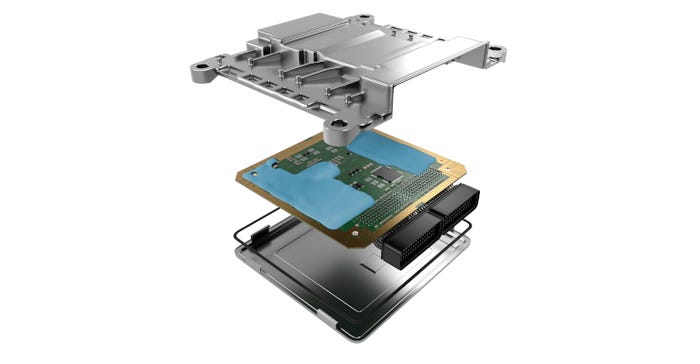Bonding Over Adhesives
Adhesives innovations are expanding applications.
February 25, 2023

From sticky notes to skyscrapers, adhesives come in many different forms and formulations. Liquid or paste, bonding on contact or needing curing steps, accommodating rigid or flexible bonds, or doubling as seals, designers would do well to keep an eye on expanding applications involving adhesives.
Getting a better understanding of adhesive types, terms, and applications is a great place to start. Founded in 1905 in Leicester, UK, as Anglo Chemical, Anglo Adhesives Co. has seen and continues to participate in that expansion. Originally supplying adhesives to the footwear industry, the company formulates and supplies adhesives for everything from construction to packaging.
How Adhesives Work
In the in-depth educational blog post “How do adhesives work?" Anglo defines an adhesive is a substance able to bond two materials together, either permanently, semi-permanently, or temporarily. Adhesive types include pressure-sensitive, rubber-based, hot-melts, polychloroprene, ultraviolet (UV)-curable, and PMMA methyl methacrylate cements, to name but a few.
The general term adhesive, the company continues, refers to glue, paste, or cement made from organic materials, which can be natural and synthetic. Natural adhesives can be from a variety of materials, including animal skin, bone, or muscle; casein (a protein found in milk); starch and dextrin (obtained from corn, wheat, potatoes or rice); or natural gums such as agar, gum arabic, or rubber latex.
Synthetic adhesives may cost more to produce, but often can ensure uniformity and consistency. Almost all synthetic adhesives, Anglo explains, are made of polymers.

Polymers
Polymers are giant molecules (or macromolecules), Anglo says, made up of thousands of smaller molecules (monomers). Polymerization (forming polymers) in the adhesive may happen before its application, making it ready to use from the container. Other polymers rely on a curing step, as in epoxy resins. Thermoplastic and thermosetting polymers also offer bonding properties. Thermoplastics provide strong, durable bonding at normal temperature, whereas thermosetting polymers create heat-resistant and insoluble bonds, the company explains.
Sticky Situations
Does glue stick because it’s sticky? Well, yes, Anglo says, but a deeper understanding involves adhesive chemical changes at a molecular level. Different bonds have different properties that make it more or less suitable for different applications. Two important forces come into play in any bonding process: adhesion and cohesion. Adhesion is the force that sticks two different things together, while cohesion is the force that keeps the same types of molecules together, Anglo explains.
Mechanical and Chemical Bonds
Adhesive bonds can be mechanical or chemical, Anglo continues. A mechanical bond occurs when an adhesive enters porous openings in the surface or flows around protrusions on the surface, Anglo explains. This type of adhesion creates a physical connection between the adhesive and surface.
Mechanical bonds aren't usually as strong as chemical bonds, which physically change the surface's chemical structure, Anglo explains. However, chemical bonds require adhesives and surfaces with mutually reactive chemical groups. A coupling agent could help join two materials that are incompatible for chemical bonding. Anglo explains that the first surface forms a chemical bond with the coupling agent, which in turn forms a chemical bond with the second surface.
Electrostatic Bonds
If that’s not enough, there are also electrostatic bonds that join two opposite-type surfaces. “When you spread the glue, it creates lots of very weak electrostatic forces between the molecules of the glue and the molecules of the surface it’s applied to,” Anglo explains. “These forces are known as van der Waals forces, named after physicist Johannes Diderik van der Waals."
Degrees of Freedom in Assembly Design
Rarely do design and manufacturing engineers have all options open to them when developing an assembly method for their product. According to the white paper “Degrees of Freedom in Designing the Right Adhesive Assembly Process,” from Ellsworth Adhesives, any number of constraints need addressing in formulating the right process strategy:
Assembly times must fall into a certain window. Normally, shorter times are preferred, but not always.
The process may be constrained by existing equipment. In the case of adhesives and sealants, dispensing and curing equipment may be fixed to current options on hand or there may be capital restrictions on new equipment choices.
Adhesive and/or sealant choices may be constrained to a list of specified or approved materials by a customer or industry group.
Performance criteria are always a part of any assembly material. Frequently, there is a need to check for assembly integrity in-line, so quality inspection systems must be factored into the assembly process.
“Overcoming process constraints requires maximum degrees of freedom in unconstrained areas,” according to Ellsworth Adhesives. “For example, where dispensing or curing equipment options are largely fixed, the assembly material of choice can be optimized to fit the equipment and other required process steps. Conversely, when specified materials must be used, make equipment choices work within process objectives.
"Manufacturers of materials and product assembly equipment tend to specialize in a relatively narrow range of products," Ellsworth Adhesives continues. The best process development partners offer a broad range of materials and equipment, and are experts in understanding interactions between product classes and how to fit them to your processing needs. In other words, solving for multiple constraints means finding maximum degrees of freedom.”
Staying Grounded
In many cases, adhesives solve for many product needs in addition to bonding. In November 2022, Dusseldorf, Germany-based Henkel announced an electrically conductive adhesive (ECA) that cures at room temperature, which improves yield rates while protecting sensitive structures within mobile device compact camera modules (CCMs) while delivering robust electrical grounding performance.
Loctite Ablestik ICP 2120 is a moisture-cure ECA, a critical feature for safeguarding the thin, miniaturized substrates within mobile device camera components. Henkel Electronics Product Development Director Toshiki Natori notes many ECA materials are solvent-cure adhesives requiring high temperatures to fully process. Loctite Ablestik ICP 2120 uses a unique chemistry platform engineered for demanding mass production and performance requirements.
In addition to its core electrical advantages, Loctite Ablestik ICP 2120’s distinctive chemistry provides a low modulus (900 MPa @ 25°C) to ensure better drop performance, as well as a curing profile for fast room- or low-temperature (50° C for 30 min) curing to enable high-volume processing, substrate protection, and reduced energy consumption. Excessive heating of smaller, thinner, more complex CCM substrates can cause warping or shrinking, impacting optical performance and decreasing yield, so limiting high-temperature exposure is essential.
Importantly, as Loctite Ablestik ICP 2120 is designed for electrical grounding, its electrical properties have been optimized for performance. The material has low direct contact resistance (DCR @
In addition, with CCM functionality expanding while footprints remain comparatively small, heat generation may also become a concern. Loctite Ablestik ICP 2120, which has a high thermal conductivity of 7.0 W/m-K, helps dissipate operational heat to improve performance and reliability.
Initially developed for CCM multi-camera applications, Loctite Ablestik ICP 2120’s characteristics may also be beneficial for other ECA applications, such as OLED display grounding or device-level EMI shielding, for example. As Natori summarizes, “The attributes of this ECA are quite distinct, allowing excellent electrical performance while protecting the delicate nature of many heat-sensitive miniaturized components and ensuring compatibility with high-volume production environments. This is a rare combination of properties and a notable advantage for mobile device designers.”

Capturing Carbons
Hydrogen (H2) is gaining a lot of attention in energy and transportation as a high-quality and renewable energy carrier, produced primarily through steam reforming of fossil-based resources. But H2 production is also accompanied by the greenhouse gas byproduct, CO2. One technology for capturing CO2 is membrane separation.
Master Bond describes in a case study that its EP46HT-2 two-component adhesive system, typically used in aerospace, petrochemical, OEM, and electronic applications, was suitable for the excessive temperatures and pressures experienced by the various membranes used in CO2 capture. The sample films were mounted on brass support disks using the heat and chemical-resistant epoxy EP46HT-2.
"The EP46HT-2 was initially cured for 3 hours at 140° C. Following the manufacturer’s directions and in order to reach optimal properties, a post cure of 3 hours at 180° C came next. Samples were attached to the permeation system and degassed overnight under vacuum at 190° C and equipped with a liquid nitrogen trap. The temperature-dependence permeabilities of the gases tested were measured," according to the case study.
Master Bond EP46HT-2 was an ideal choice for such temperature-dependent research, as the service temperature range of extends from -73° C to +260° C and its decomposition temperature being > 350° C. In addition, because the epoxy is 100% reactive and does not contain solvents or diluents, there are no volatile compounds to interfere with gas readings.
Keeping Sensitive Circuit Boards Secure
As mentioned earlier, adhesives can pull double duty as sealants given the right circumstances. Developed by Panacol, Structalit 5801 is a new two-component adhesive system that demonstrates chemical and moisture resistance after accelerated aging. This resistance suits Structalit 5801 for the structural bonding and potting of electronic components that require maximum environmental protection.
Structalit 5801 is a black, two-component epoxy adhesive system with a simple 2:1 mixing ratio. Curing takes place within 12 hours at room temperature. For faster processing, this adhesive can also be cured thermally, in as little as 30 minutes at a moderate temperature of 80° C. Lower temperature curing minimizes thermal stress on components, and the shorter cycle time improves productivity. This medium-viscosity adhesive blend adheres to metals including aluminum and stainless steel. It is well suited for the structural bonding of metal frames and housings. Structalit 5801 also exhibits very good adhesion to plastics, such as PA6 GF or PBT. This multi-substrate adhesion allows Structalit 5801 to be used for many material combinations typically found in the consumer and automotive electronics industries.
This newly developed adhesive cures with low shrinkage and exhibits good vibration and shock resistance given its high bond strength and unitizing properties. Aging tests at temperatures above 130°C revealed Structalit 5801 actually gaining bond strength. Adhesive exposure to transmission oil, biodiesel, and alcohol during aging resulted in minimal loss of bond strength. This is mainly owing to the high degree of crosslinking and the low moisture absorption of this adhesive.
Structalit 5801 can be dispensed from a 50-ml dual-chamber cartridge, suiting it for manual, short-run, or semi-automated production. This epoxy system is also available in sedimentation-stable bulk containers that can be used with meter-mix equipment for high volume production.
Stuck for a process or product advantage? Think adhesives.
About the Author(s)
You May Also Like





